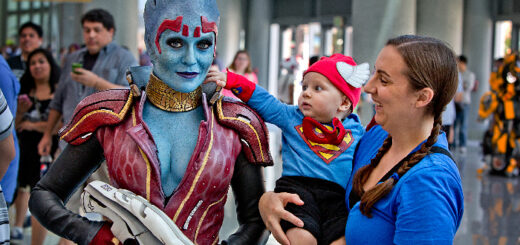John Ostrander: Wonder(ful)Con 2015
Last weekend, while my column was here, I was not. I was an invited guest at WonderCon out in Anaheim, CA, and I had a great time. It reminded me of San Diego Comic Con (who owns WonderCon) back before SDCC got so huge and overwhelmed with media stuff. WonderCon was mostly about comics and that felt very cool.
My duties were pretty light – two panels and two hour-long autograph sessions and one video interview. I didn’t have a table (my own fault) so I had a chance to walk around unfettered and unsupervised and see what I wanted. I didn’t realize fellow ComicMix columnists Jen Ernst and the Tweeks were also in attendance or I would’ve made an effort to get together with them and say hello and exchange stories about Mike Gold.
One of the big impressions I had was the sheer amount and quality of cosplayers in attendance. Every corner of fandom was there – comics, Doctor Who, Star Trek, Star Wars, every sf movie or TV show you could think of. Some were mash-ups of different groups, such as Princess Merida (Brave) as a Jedi. I was dazzled.
What I initially thought was an interesting cosplayer turned out not to be a cosplayer at all. A guy with a bullhorn outside the security gates was haranguing everyone; turns out he was a Westboro Baptist-type preacher going on about sin and Jesus and the devil; I wasn’t listening very closely. Side observation: why do so many of these preacher types go on about the devil so much? They talk more about him than Jesus, it seems to me.
Anyway, his church also had some placards up with red letters against a yellow background with variations of “Jesus is Lord.” My second day there I saw one such sign inside the security barrier and wondered how they got past the guards. Then I realized it was being held by a Stormtrooper, probably from the 501st, and in red letters against a yellow background it said, “Vader is Lord.” Well played, 501st; well played.
I got to see some of my fellow professionals during the Con; my fellow Legends scribe Len Wein was there and we exchanged heart surgery notes. I had a triple bypass last October but Len had a quadruple bypass only six weeks before. (He’s so competitive.) I would not have been at the Con in his shoes and I hope all the fans really appreciated his being there. Len is one of the nicest guys in the biz and goes that extra mile for the fans.
Dan Jurgens stopped by while I was having breakfast on Friday ,which was nice. I later stopped by his table and we shot the shit about some of the old days at DC.
I also met up with Barbara Randal/Kesel/Kesel Randal/Randal Kesel/whatever. We ran into each other outside the Convention Hall and that is a very difficult trick to pull off. The odds against meeting anyone you know at one of these things is astronomical.
Barbara, I and my late wife Kim Yale were good friends back at DC when Kim worked there and it was still headquartered in NYC. Barbara has hardly changed at all and that should be illegal. I myself am old and weathered and show my years as any decent person should.
I went to a panel that Barbara was moderating called “What Does an Editor Do” which was fun, quick paced, and informative. A really good panel. During Q&A I asked her and her panelists who was an example of a good editor in the past. Barbara nailed it with her answer: “Archie Goodwin.” Boom! There it is. Great writer, great editor.
I also met some other professionals for the first time – Marc Andreyko and Tom King. Marc you may know from his version of Manhunter, which starred Kate Spencer. Kim and I had worked on a Mark Shaw Manhunter series so that gives us a bit in common.
We were both hanging around the Con booth for different reasons and I was trying to think of some way of introducing myself without sounding like a dweeb. Evidently, he was doing the same and we finally broke the ice and had a great conversation.
You may know Tom King from his current work on Grayson as well as his novels. He came up to say hello and introduce himself during one of my autograph sessions. A really nice guy and I enjoyed meeting him; he confessed he was a little nervous about meeting me. (I can give him names of people who can tell him how and why I am not so impressive.) I told him stories about how I dweebed out in meeting some of those pros I revered (Jack Kirby, John Broome, and Will Eisner). Tom and I got along fine after that.
Both Tom and Marc mentioned how my work on Suicide Squad really impacted them. That always surprises me when I hear that. These guys are hot, young and very good writers. All false modesty aside, I’m sometimes surprised that people remember what I did; I was just trying to do my best at the time. Like I always do.
The two autograph sessions went very well. Both lasted an hour each and I was busy right through each hour. I got to chat with some of the fans and see some of my old work which was sort of like seeing old friends. A couple of the fans had my very first work which was an eight page story in the back of the first issue of Warp, the first comic from First Comics.
The two panels were fun. One was my solo panel – all about me, a subject I know fairly well and can talk endlessly about. It was a relatively small crowd so I had them all move down to the front of the room and I sat on a chair in front of them and we just chatted. I told stories, held forth about writing, and everyone seemed to have a good time.
The other panel was about working on Star Wars and the room was packed. I shared the podium with several of my fellow workers and we fielded answers from the crowd. Towards the end, I asked the audience a question, one that I felt went to the very heart of Star Wars.
Did Han shoot first?
The answer was a deafening “Yes!”
Damn straight.
A good Con, all in all. I want to thank everyone connected with it and thank them for inviting me and taking really good care of me. I had such a good time I’m hoping to go back. If I have the money, I would pay my way.
And for those who know me, you know that’s a high compliment.
























